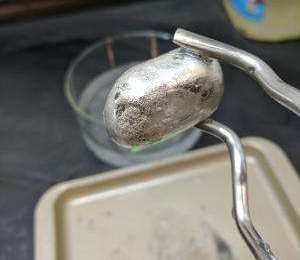University of Colorado Boulder engineers have revamped a World War II-era process for making magnesium that requires half the energy and produces a fraction of the pollution compared to today’s leading methods.
The breakthrough process, developed in the labs of Professor Alan Weimer, could vastly improve production of the strong, lightweight metal that’s used in everything from vehicles and aircraft to dietary supplements and fireworks. Now, CU Boulder spinoff company Big Blue Technologies (BBT) is working to translate the laboratory innovations into a viable commercial-scale enterprise.
“I’m doing it in the lab; I’m seeing the product and seeing the results,” said Boris Chubukov, a graduate researcher in CU Boulder’s Department of Chemical and Biological Engineering and one of Big Blue Technologies’ co-founders. “I know the potential is really there.”
A few different methods currently exist for creating magnesium metal, but the most common one takes ore from the ground, combines it with expensive silicon and uses extremely high heat—around 1,200oC—to create chemical reactions and extract the magnesium in small batches.
Recent PhD graduate Aaron Palumbo, along with graduate students Scott Rowe and Chubukov, sought a better way.
They swapped cheap, abundant carbon for the silicon reactant and addressed flaws in the production process, landing on a system that requires much less energy. They also managed to extract magnesium continuously, rather than in batches, and eliminated the solid waste commonly formed.
The Advanced Research Projects Agency-Energy, a division of the US Department of Energy, provided the $3.6 million grant to Weimer’s lab that funded the preliminary research.
The technology could have global economic implications. Metal smelting has increasingly moved overseas, mostly to China, in attempts to reduce the overall cost of manufactured goods. Until the late 1990s, the US was a major world supplier of magnesium, but today, only a single domestic producer remains, according to the US Geological Survey.
But the BBT founders believe this new process could change the equation and they’ve secured almost a half-million dollars so far from backers who agree, Palumbo said. That includes a $225,000 seed grant from the National Science Foundation’s Small Business Technology Transfer program.
“In our economic projections, if you built a plant in the U.S., with current energy prices and fair, first-world labour wages and benefits, we could still produce magnesium cheaper than Chinese product,” Palumbo said. “The US can only begin to ‘bring back manufacturing jobs’ if there is abundant access to cheap raw materials and if we continue to lead in innovative developments for process technology.”
Early this year, the fledgling company formed a partnership with Nevada Clean Magnesium, a publicly traded company, to further develop, test and improve the production method. BBT also won the “Most Impact” award at the Cleantech Open Global Forum in February, the culmination of a yearlong accelerator for early-stage clean technology startups. They also graduated from Catalyze CU, the university’s startup accelerator, in 2015.
Nevada Clean Magnesium is focused on becoming a major US producer and distributor of primary, high grade, low cost magnesium extracted from its 100% owned Tami-Mosi property located in north central Nevada. Based on the Company’s NI 43-101 PEA published in September 2011 and amended in July 2014, the Tami-Mosi project has an inferred resource of 412 Mt with an average grade of 12.3% Mg for a contained metal content of 111 billion pounds of magnesium using a 12% cutoff grade contained within a high purity dolomite block.










